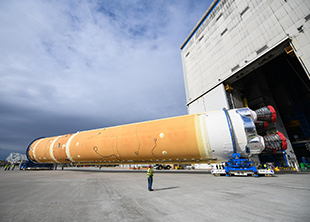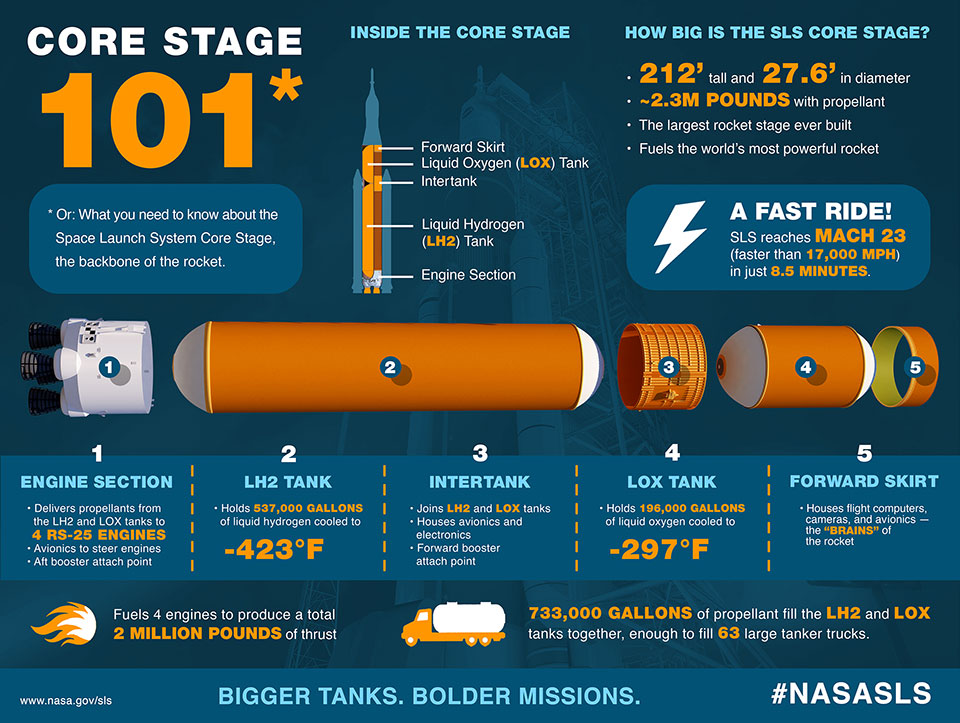OVERVIEW
Building the Future of Human Spaceflight Beyond Earth

NASA's Space Launch System (SLS) provides a critical heavy-lift capability built to rigorous human-rated safety standards to carry people and cargo back to the moon – this time to stay – and on to Mars.
SLS will launch larger payloads farther in our solar system, faster than ever before possible. It will be the most powerful rocket ever built, enabling diverse exploration, science and security missions. SLS is also the world’s only super heavy rocket capable of safely transporting astronauts to deep space with major payloads like landers, habitats and Gateway elements.
Boeing is the prime contractor for the design, development, test and production of the launch vehicle core stage, as well as development of the flight avionics suite.
Core Stage 101

Missions
The first test flight, Artemis I, will carry an uncrewed Orion space capsule to the moon to test the performance of the integrated system. SLS also will carry 13 small satellites, each about the size of a shoebox, that will be deployed in deep space.
Additional missions are planned with this configuration as the even more powerful Block 1B version of the rocket is designed and built. This follow-on, evolved two-stage configuration will provide a lift capability of more than 105 metric tons, using the Boeing-built Exploration Upper Stage. Boeing has delivered flight hardware for the first Artemis mission and is producing flight hardware for both the second and third missions.

LAUNCH ESCAPE SYSTEM

A launch escape system (LES) or launch abort system (LAS) is a crew safety system connected to a space capsule, used to quickly separate the capsule from its launch vehicle rocket in case of a launch abort emergency, such as an impending explosion. The LES is typically controlled by a combination of automatic rocket failure detection, and a manual activation for the crew commander's use. The LES may be used while the launch vehicle is still on the launch pad, or during its ascent. Such systems are usually of two types:
A solid-fueled rocket, mounted above the capsule on a tower, which delivers a relatively large thrust for a brief period of time to send the capsule a safe distance away from the launch vehicle, at which point the capsule's parachute recovery system can be used for a safe landing on ground or water. The tower and rocket are jettisoned from the space vehicle in a normal flight at the point where it is either no longer needed, or cannot be effectively used to abort the flight. These have been used on the Mercury, Apollo, Soyuz, and Shenzhou capsules.
The crew are seated in ejection seats as used in military aircraft; each crew member returns to Earth with an individual parachute. Such systems are effective only in a limited range of altitudes and speeds. These have been used on the Vostok and Gemini capsules.
GENERAL INFO
- Created On: Android
- Game Version: 0.9.307.0
- Price: $98,305k
- Number of Parts: 177
- Dimensions: 146 m x 11 m x 24 m
PERFORMANCE
- Total Delta V: 34.3km/s
- Total Thrust: 48.8MN
- Engines: 12
- Wet Mass: 3.64E+6kg
- Dry Mass: -4,064,288kg
STAGES
| Stage | Engines | Delta V | Thrust | Burn | Mass |
|---|---|---|---|---|---|
| 1 | 6 | 31.8km/s | 42.3MN | 11.3m | 3.64E+6kg |
| 3 | 1 | 1.5km/s | 2.5MN | 2.2m | 2.88E+5kg |
| 5 | 1 | 940m/s | 900kN | 2.0m | 1.39E+5kg |
| 8 | 0 | 0m/s | 0N | 0s | 36,584kg |
No Comments
4 Upvotes
Log in in to upvote this post.








